Staying still is not a choice in a digital market racing toward $8 trillion in worldwide sales by 2027. Many companies find out too late that the incorrect platform might deplete resources, irritate consumers, and slow development at the worst possible moment.
That is when ecommerce platform migration services become a deliberate action to reveal improved performance, more scalability, and a more seamless consumer experience. You will learn in this book what migration is, why you may need it now more than ever, and the practical procedures and insider advice to guarantee your replatforming trip is smooth.
What is eCommerce Migration?
Ecommerce migration services, at their core, are services that move a complete store to another platform (e.g., migrating from Shopify to Magento, Salesforce Commerce Cloud to BigCommerce; Magento 1 to Magento 2). That said, deciding to migrate ecommerce website assets means you are also moving several critical pieces, including product data, consumer data, design themes, and functional modules, to build an online store that is not only better and faster but also more scalable.
So why would companies pay for ecommerce platform migration services? In many cases, their current system slows them down. It may also lack the flexibility to support features that modern customers expect, such as meaningful search, personalization, or faster checkouts. Companies can improve site speed, security, and access to innovation, maintaining competitiveness in an ever-evolving market, by migrating.
Alternatively, there is not one method to replatform either. Some companies opt for complete ecommerce migration solutions covering everything from design to backend technologies. Others undertake phased migrations, transporting portions of their inventory in phases to minimize disturbance. You ought to be aware of several fundamental varieties of migration:
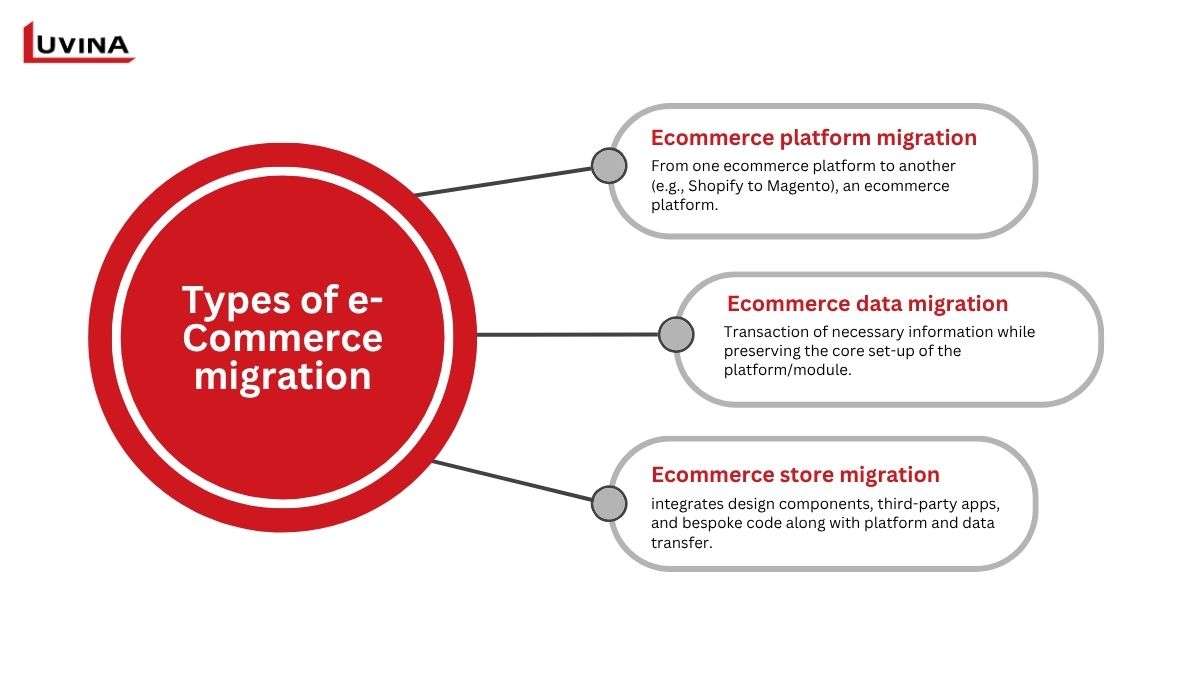
- Ecommerce platform migration: From one ecommerce platform to another (e.g., Shopify to Magento), ecommerce platform migration entails the complete transition. It is the most extensive move, affecting your whole site infrastructure and usually necessitating integration, workflows, and hosting changes.
- Ecommerce data migration: Focused on the transaction of necessary information such as transactions, customer details, and orders while preserving the core set-up of the platform/module. It is especially significant when upgrading to a new version of the same platform or when merging storefronts/stores.
- Ecommerce store migration: This integrates design components, third-party apps, and bespoke code along with platform and data transfer. Usually, the option for companies seeking a fresh start with better branding and new features is this one.
Reasons to Migrate Your eCommerce Platform & Website
A recent Digital Commerce 360 report found that 76% of B2B sellers and over a quarter of retailers plan to replatform within the next year. This is exactly where ecommerce platform migration services can make a difference.
The most typical reasons companies opt for platform migration for ecommerce are listed here, along with the rationale planned ecommerce site migration might be the best decision for your development.
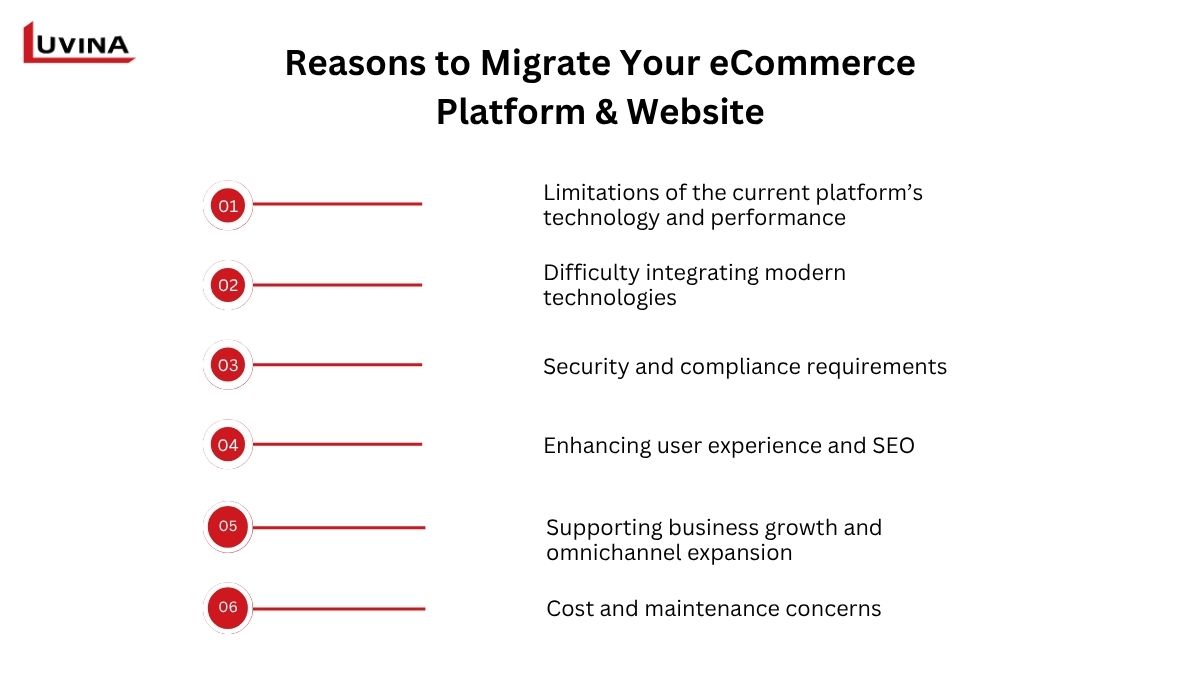
- Limitations of the current platform’s technology and performance: Old systems may find it difficult to manage heavy traffic, big product catalogs, or unexpected demand surges. Bad performance can annoy consumers and damage conversions. Studies reveal that 53% of smartphone users give up on websites that take longer than three seconds.
- Difficulty integrating modern technologies: Modern ecommerce depends on flawless interactions with ERP systems, CRM tools, payment gateways, and AI-powered apps, therefore complicating the implementation of modern technology. Your platform makes it more difficult to adapt, automate, and personalize the buying experience if it lacks this agility.
- Security and compliance requirements: Security of customer data is not optional. You could face fines or violations when older systems are still guilty of significant criteria (i.e., PCI DSS, GDPR). Migrating to a secure and modern platform provides better built-in defenses.
- Enhancing user experience and SEO: An unresponsive and awkward site will lose users and lower your search rankings. Improvements guarantee higher page load speed, better URL structure, and a mobile-first layout to keep users interested and search engines happy.
- Supporting business growth and omnichannel expansion: A modern platform lets you manage everything under one roof as your organisation grows across new markets or sales channels, hence simplifying your operations. This eliminates data silos and leads to better insights for wiser decisions.
- Cost and maintenance concerns: Legacy systems sometimes have hidden costs. Studies indicate that, without suitable optimization, companies overspend on outdated cloud resources by up to 70%. You may reduce overhead and free your staff to focus on growth by switching to a contemporary solution.
Done right, website platform migration helps you break free from old limitations and build a more resilient, future-ready store.
Key Challenges in eCommerce Platform Migration
Though the benefits of a well-executed migration are obvious, the road there is not free from challenges. Many companies ignore the difficulty of moving a whole store; therefore, it’s important to rely on either recommerce platform migration services or online store migration services to minimize risk and disturbance.
The most often occurring difficulties you should monitor are listed here:
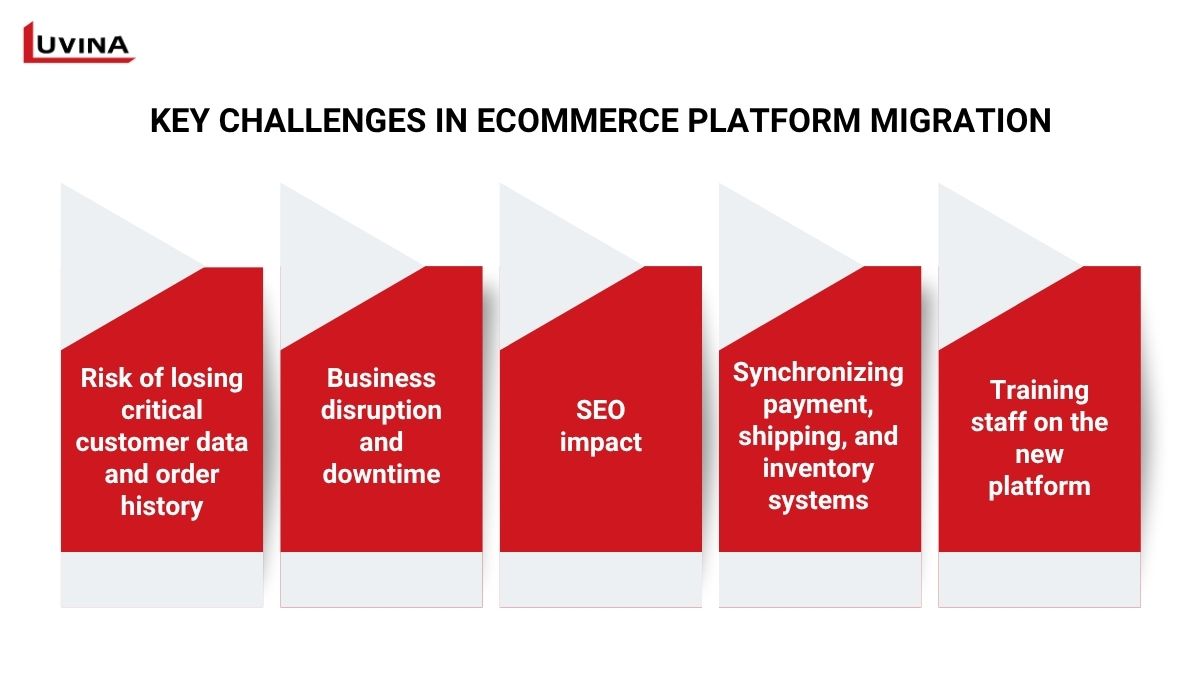
Risk of losing critical customer data and order history
Little mistakes in payment information, consumer profiles, or buying histories can irritate customers and cause income to decline. Every phase of a sure migration plan needs to include strong data mapping, testing, and validation.
Business disruption and downtime
Every minute your store is off during migration reflects lost revenue and broken trust. Many businesses neglect to account for how downtime will affect their processes. Revenue loss and consumer annoyance may be reduced by using a staging environment, scheduling changes during low-traffic periods, and stress testing the new configuration.
SEO impact
If not properly controlled, alterations to the structure, URLs, and metadata of your site during migration can lead to a fall in keyword ranks. Broken links or missed redirects could overnight cut organic traffic. A successful migration means a detailed SEO audit, applying the correct 301 redirects, new sitemaps, and ongoing tracking if you care about your search performance.
Synchronizing payment, shipping, and inventory systems
Your ecommerce store depends on real-time connections with systems like payments, shipping, and inventory. Even a small incompatibility during migration could lead to failed orders, overselling, or shipping delays. In order to make sure operations are in place, all integrations must be very well tested before you go live.
Training staff on the new platform
Even the most fully functioning online shop will not enjoy success if everyone on the team is hesitant to use it. A brand new platform could come with new or strange customer care processes, dashboards, or workflows. Budget time and resources for your team’s training to manage orders, refresh content, and assist customers from day one!
Core Components of a Successful eCommerce Migration Service
Behind every smooth migration is a clear roadmap. And the best ecommerce platform migration services follow a proven framework that reduces risks and ensures your store runs better than ever. Here are the core components you shouldn’t overlook:
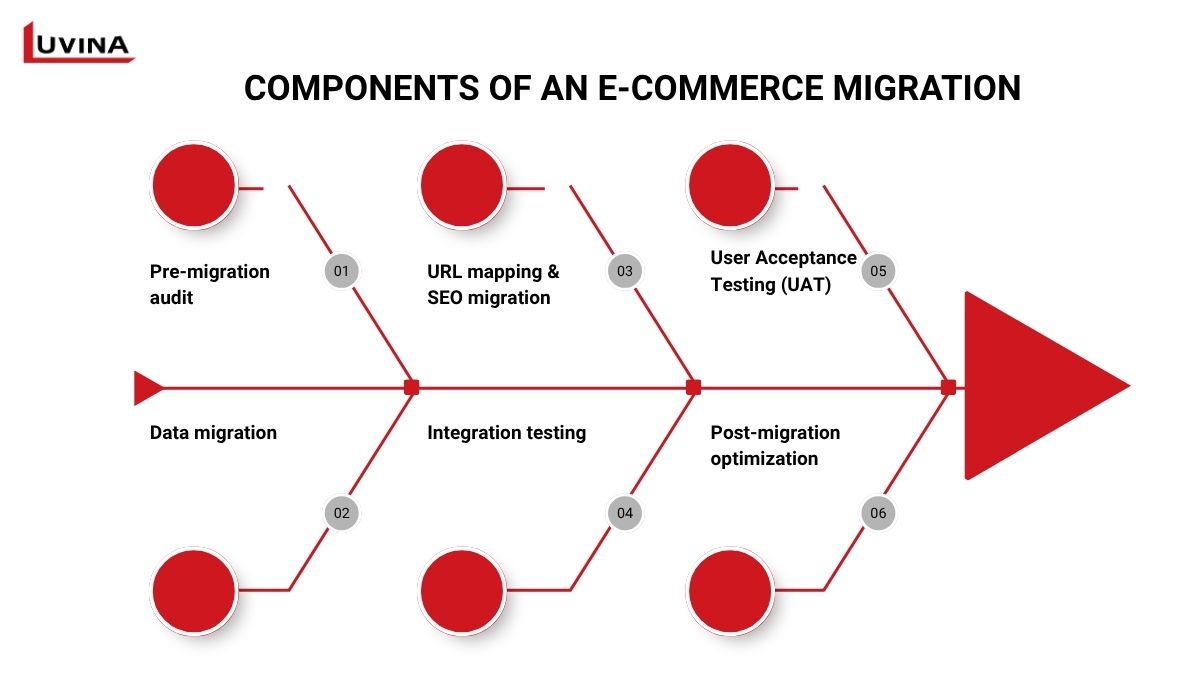
- Pre-migration audit: An early identification of possible problems and selection of the best approach is achieved by an analysis of the technological stack, processes, and business needs of your present site.
- Data migration: Securely moving your transaction records, consumer profiles, order histories, and product catalogs so nothing is damaged or lost during the switch.
- URL mapping & SEO migration: You need to be prudent so you don’t adversely affect your search rankings. It is about a 301 redirect to maintain (or elevate) your organic traffic when migrating. You will want to keep the total number of backlinks pointing to your old site, and ensure your new URL structure is fully in place by deploying a URL mapping, even if you have your domain point to the new site.
- Integration testing: Comprehensive integration testing ensures your ERP, CRM, payment processors, shipping, and inventory tools work as expected on the new platform.
- User Acceptance Testing (UAT): Before going live, test your migration in the real world. UAT asks real users to explore the new site as consumers would, placing orders, making payments, and looking for any obstacles.
- Post-migration optimization: Catching data inconsistencies or technical problems that can show in the first few weeks depends on proactive monitoring, bug correction, and performance tuning. Establishing strong analytics and a quick response strategy will help you maintain store operations and customer satisfaction.
Step-by-Step Process for Platform Migration
Though no two ecommerce platform migration services are exactly alike, the most successful ones adhere to a tried and true methodology. Here is a straightforward, practical road map.
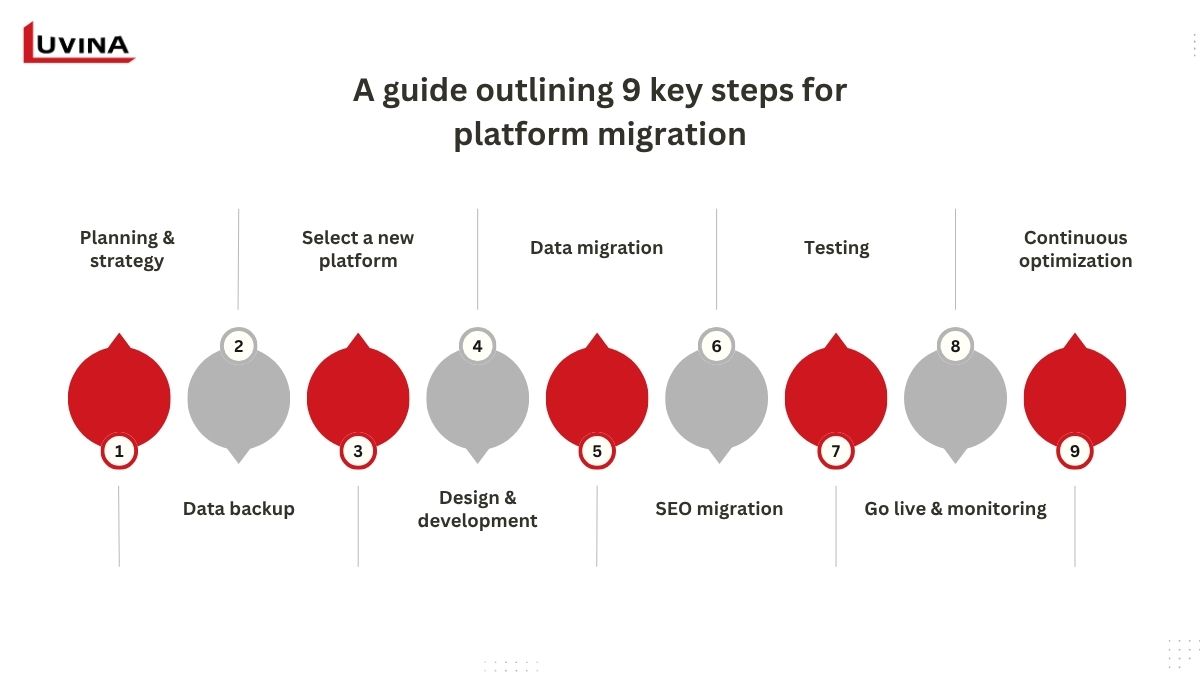
1. Planning & strategy
This initial stage includes setting realistic timelines, budgets, and clear goals for replatforming. A full audit of your current store will help identify opportunities, performance gaps, or missing features. Moving forward, you will want to outline anything that needs migration, integrations, capacity that will be needed, and identify what the key milestones will be to move the project towards completion! The rest of the migration will be as smooth as your plan is strong.
2. Data backup
Moving large amounts of data can be unexpected, regardless of how meticulously you plan; thus, a total backup is non-negotiable. Begin cataloging all current content, consumer profiles, and transaction data by crawling your entire store as part of any Ecommerce replatforming project.
Next, determine what can be left behind and what is worth migrating. Cleaning up old or low-value material right now will help your new store be more SEO friendly and lean. Once you decide upon what you are leaving behind, make sure you have a reliable backup of everything (order history, customer data, product catalogs, and all of the important functionality of the site).
Having a good backup strategy allows you to quickly restore your site and mitigate downtime or lost sales if something fails during migration.
3. Select a new platform
One of the first and most crucial stages in any e-commerce migration is selecting the appropriate location. First, precisely outline your business objectives and must have. This will enable you to evaluate Magento, Shopify Plus, BigCommerce, WooCommerce, or any other fit that scales and budget.
Start by shortlisting five or six potential providers using trusted sources like G2, Capterra, or Gartner. Then, prepare a detailed list of requirements. If needed, send out an RFP to compare providers more effectively.
Once your shortlist is ready, arrange exploratory discussions with each supplier. Prices are not the only thing to consider. Ask about the costs and timelines associated with getting your data migrated, how the provider helps with migration, what customer service looks like post-launch, and the platform’s security and compliance accommodations. Analyze scalability, uptime performance, and out-of-the-box connections to evaluate if the platform can scale with you.
Last, maintain a shared document of the answers and comments so that your team may review choices side by all.
4. Design & development
It’s time to realize your vision once your selected new platform gets with your designers and developers to work together during this stage to create a strong backend and an interesting, user-friendly storefront.
Reliable ecommerce platform migration services will help you rethink the UI/UX of your website, improve navigation, and introduce fresh functionalities better suited to your clients. This is also the phase to import and evaluate all the information you have moved, so guarantee the correct display of product catalogs, consumer accounts, and order history.
5. Data migration
This is the stage at which all the data keeping your store operation is transferred safely to your new platform. Data migration should double-check that everything is mapped accurately and checked for uniformity. Any now missing records or mistakes could result in more serious problems later. Taking the time to review, test, and validate that all data shows as it should on your new site guarantees a smooth transition that does not interrupt your business or your clients.
6. SEO migration
Protecting your well-deserved search rankings should be your priority when you migrate ecommerce website data to a new platform.
Begin by creating a clear, onetoone redirect plan so every old URL points to its new equivalent redirect plan to remove outdated or duplicate pages. Then, audit your current material. Make sure to move all schema markup, on-page SEO components, and metadata, and maximize them where feasible to fit with your keyword strategy.
Submit your revised sitemaps to search engines after launch; monitor ratings, index status, and crawl faults using Google Search Console or SEMrush.
7. Testing
This step will enable you to discover any technical, data, or usability issues that will lower the performance of your store after it goes live.
First, test the full technical functionality of the navigation, product pages, checkout path, and, of course, any back-end functionality of your new platform. You will also want to check page speed and overall site health using performance tests such as Google PageSpeed Insights.
Stop at neither technical testing. User testing reveals real-world pain areas that automated systems may overlook, while security checks ensure sensitive information is kept safe. Invite several team members to help from both an admin’s and a customer’s viewpoint to investigate the site.
Where feasible, provide trusted clients with beta access and request comments on their experience.
8. Go live & monitoring
Smooth launching starts with planning. Choose a low-traffic window, or low-impact time, to reduce risk, while using a checklist to make sure you work through every step in order and on schedule.
Once your website is live, stay vigilant. Even with the best ecommerce platform migration services, surprises can still occur, especially in the first few days or weeks after launch.
- – To identify issues around speed, broken links, or inaccurate analytics, it will depend on monitoring the performance of the site, customer journeys, checkout flows, and analytics.
- – Establish alerts and monitoring systems to identify any unusual activity; have your development crew ready to address problems quickly.
9. Continuous optimization
After your new site has launched, pay attention to real user behavior and feedback and look for opportunities to fine-tune your site. You may find some great insight into unanticipated bugs, UX bumps, or performance slowdowns that did not arise in testing. And you can always use analytics, heatmaps, and customer surveys to see how they are using your store, and more importantly, where they are dropping off!
When you regularly update your store, make performance adjustments, and improve or add features, you can take advantage of your new platform and keep your store operationally functional for well past your launch day.
Luvina Software – The Right eCommerce Migration Service Provider
Having a seasoned partner by your side makes all the difference when you choose to migrate ecommerce website operations to a different platform. At Luvina Software, our committed team provides thorough ecommerce platform migration services meant to manage every facet of your relocation: from planning, design, and development to post-launch support.
To grasp your business objectives and difficulties, we begin with a tailored consultation. We then design a step-by-step migration plan to guarantee your new store operates flawlessly with little disturbance. You will never be left wondering with our open procedure, affordable solutions, and round-the-clock professional assistance. Additionally, our dedication to on-time delivery lets you stay concentrated on development while we manage the heavy lifting backstage.
Ready to upgrade and future-proof your online business? Contact Luvina Software right now to get started!









Read More From Us?
Sign up for our newsletter
Read More From Us?
Sign up for our newsletter